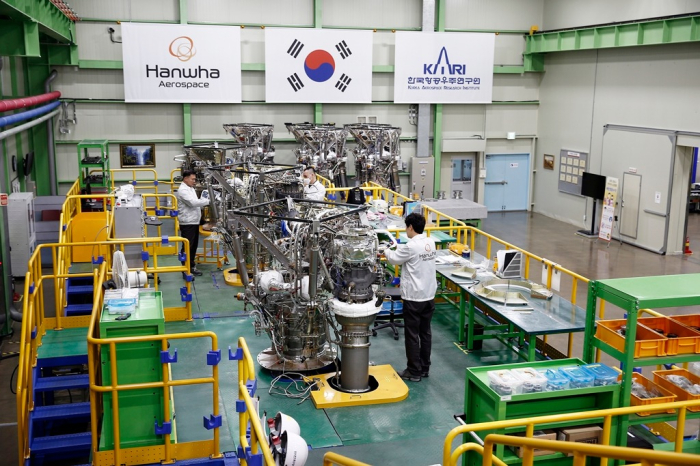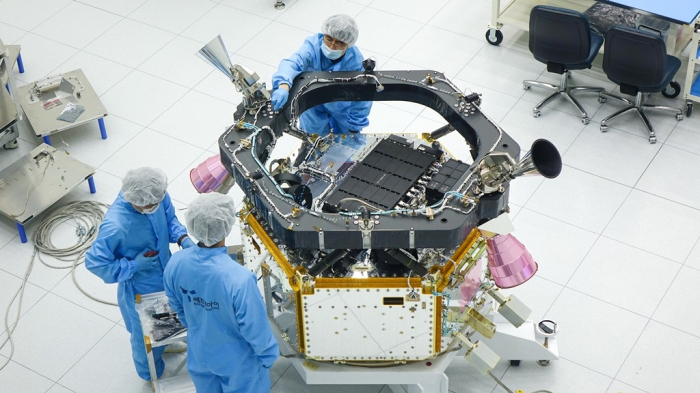Aerospace & Defense
Hanwha Aerospace, home of Korea’s next-generation space industry
Hanwha Aerospace has allied with Hanwha Systems, Satrec to foster the group’s space business
By Feb 23, 2024 (Gmt+09:00)
3
Min read
Most Read
LG Chem to sell water filter business to Glenwood PE for $692 million


Kyobo Life poised to buy Japan’s SBI Group-owned savings bank


KT&G eyes overseas M&A after rejecting activist fund's offer


StockX in merger talks with Naver’s online reseller Kream


Mirae Asset to be named Korea Post’s core real estate fund operator



CHANGWON, South Gyeongsang Province – South Korea’s Hanwha Aerospace Co. aims to establish a foothold in the global rocket industry dominated by Elon Musk’s SpaceX through its technology accumulated in manufacturing the engines of the country’s homegrown projectiles.
Hanwha Aerospace has manufactured 46 space rocket engines so far, including those for the nation’s first space rocket, Nuri, at its flagship space product manufacturing facility in Changwon, about 380 kilometers (236 miles) southeast of Seoul.
“We aim to secure launch service capabilities based on our experience in manufacturing liquid-propellant rocket engines and operating Nuri,” Lee Joon-won, senior vice president and head of the space business group at Hanwha Aerospace, told reporters on Tuesday.
“We will be able to make inroads into the global launch service market once we are as competitive as Russia’s Soyuz or India’s launch vehicles,” Lee said.
Hanwha Aerospace combined the space business units of group affiliates to create a hub organization for the sector. The aircraft engine parts-making unit of South Korean conglomerate Hanwha Group develops rockets, while its subsidiary Satrec Initiative Co. produces satellites. Hanwha Systems Co. the group’s aerospace and defense unit Hanwha Systems Co. handles satellite services.
The chemicals-to-defense group has invested 894 billion won ($672.8 million) in the space industry.
RESPONSIBLE FOR NATIONAL SPACE PROJECT
Hanwha Aerospace’s Changwon plant, unveiled to the press for the first time this week, has a large national flag on the wall, showcasing the company’s responsibility for the South Korean space project. US manufacturers working for the National Aeronautics and Space Administration also hoist the Stars and Stripes at their main gates.
Hanwha Aerospace engineers are proudly participating in the national space project and are currently assembling six engines for Nuri, the South Korean-type space projectile.
Those engines must be made with special materials as they need to withstand extreme temperatures. Engineers need to manage errors by micrometers as tiny cracks in the mold will obstruct precise assembly, the company said.
Nuri’s first-stage rocket needs four 75-ton liquid fuel engines to launch from the ground, while the second stage uses one 75-ton liquid fuel engine. A 7-ton liquid fuel engine is used in the third stage, driving the spacecraft body up to the altitude of its orbit.
It requires 458 processes with some 2,400 parts to assemble a 75-ton engine, which will ignite only when the valves and components supply fuel and oxidizing agent accurately operate in order in less than a second. The engine can explode if the orders are mixed up as it consumes 255 kilograms of fuel and oxidizing agent per second.
The engine is propelled when kerosene reacts with liquid oxygen at minus 183 degrees Celsius. Once the combustion starts, the temperature inside the engine surges to 3,000 degrees Celsius.
It usually takes about three months to assemble an engine. Hanwha Aerospace said accumulated know-how halved the assembly time.
SPACE FORCE ALLIANCE
Satrec is manufacturing the SpaceEye-T, a commercial earth observation satellite with the world’s highest resolution.
The SpaceEye-T can recognize objects about 30 centimeters in width and length as one pixel. The satellite priced at about $100 million will be launched in 2025.

Hanwha Systems is developing electro-optical (EO), infrared radiation (IR) and synthetic-aperture radar (SAR) payloads, which act as a satellite’s eyes.
Write to Kyung-Ju Kang at qurasoha@hankyung.com
Jongwoo Cheon edited this article.
More to Read
-
 Aerospace & DefenseHanwha Aerospace to launch 4 more Nuri rockets under $220 mn project
Aerospace & DefenseHanwha Aerospace to launch 4 more Nuri rockets under $220 mn projectDec 02, 2022 (Gmt+09:00)
2 Min read -
 Aerospace & DefenseS.Korea ushers in new space era with rocket launch success
Aerospace & DefenseS.Korea ushers in new space era with rocket launch successJun 21, 2022 (Gmt+09:00)
3 Min read -
 Aerospace & DefenseKorea’s Nuri: Mission unaccomplished, but one step closer to space
Aerospace & DefenseKorea’s Nuri: Mission unaccomplished, but one step closer to spaceOct 21, 2021 (Gmt+09:00)
5 Min read -
 Tech, Media & TelecomHanwha-invested OneWeb’s internet satellites launched into orbit
Tech, Media & TelecomHanwha-invested OneWeb’s internet satellites launched into orbitOct 15, 2021 (Gmt+09:00)
1 Min read -
 Mergers & AcquisitionsHanwha Systems invests $300 million in UK satellite firm OneWeb
Mergers & AcquisitionsHanwha Systems invests $300 million in UK satellite firm OneWebAug 12, 2021 (Gmt+09:00)
3 Min read
Comment 0
LOG IN


